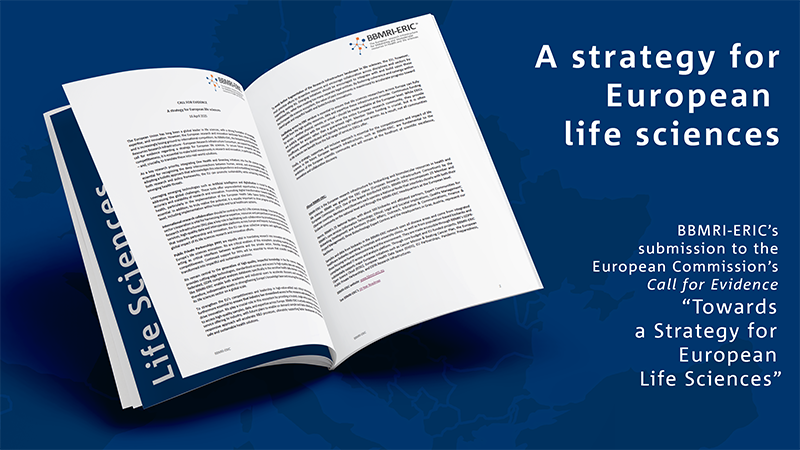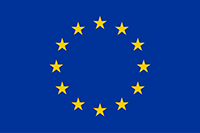I am looking for information as
Researcher

Industry

Patient

BBMRI-ERIC’s Strategy for European life sciences – A submission to the EC’s Call for Evidence
Towards a Strategy for European Life Sciences
This article is 1,293 words and a five-minute read.
The European Commission is preparing a new Strategy for European Life Sciences, to be adopted in 2025. As one of the largest ERIC’s, BBMRI followed the European Commission’s invitation to provide its feedback in the open call for evidence “Towards a Strategy for European Life Sciences”. The new multidisciplinary strategy aims to boost competitiveness and prosperity, accelerate the green and digital transitions, create new jobs, and reduce dependency on external sources.
The European Union has long been a global leader in life sciences, with a strong foundation of knowledge, expertise, and innovation. However, the European research and innovation landscape faces critical challenges. BBMRI-ERIC supports the initiative and call for evidence regarding a strategy for European life sciences.
A strategic, supportive, and inclusive approach is essential for the competitiveness and impact of life sciences in the future. European Research Infrastructures, such as BBMRI-ERIC, are fundamental to the ambitions of the European scientific community and will remain at the forefront of scientific excellence, innovation and collaborative discovery.
Read the full strategic paper below (or download the pdf here) to explore BBMRI-ERIC’s strategic thoughts on:
- One Health and Greening
- Artificial Intelligence and Innovation
- International research collaboration
- Public Private Partnerships (PPP)
- Generation of high-quality, impactful knowledge
- Ensuring streamlined industry access to resources and services
- Avoiding further fragmentation of the Research Infrastructure landscape in life sciences
- Facilitating access to ERIC services
CALL FOR EVIDENCE – A strategy for European life sciences
The European Union has long been a global leader in life sciences, with a strong foundation of knowledge, expertise, and innovation. However, the European research and innovation landscape faces critical challenges and is increasingly losing ground to international competitors. As BBMRI-ERIC, the Biobanking and Biomolecular Resources Research Infrastructure – European Research Infrastructure Consortium, we support the initiative and call for evidence regarding a strategy for European life sciences. To secure future prosperity and global competitiveness, it is essential to make bold investments in research and innovation, in particular in life sciences, – and, crucially, to translate these into real-world solutions.
As a key research priority, integrating One Health and Greening initiatives into the life sciences strategy is essential for recognising the deep interconnections between human, animal, and environmental health. By adopting a holistic approach that acknowledges this interdependence and embedding One Health principles into both research and policy frameworks, the EU can promote sustainability while enhancing resilience against emerging health threats.
Leveraging emerging technologies such as Artificial Intelligence and digitalisation is crucial for effectively addressing the global challenges. These tools offer unprecedented opportunities to improve the efficiency, accuracy and scalability of research and innovation. Promoting digital transformation towards datafication in health, particularly in the implementation of the European Health Data Space (EHDS) Regulation will be essential. In addition, to truly realise the potential, it is equally important to drive progress at the grassroots level, including implementation within hospitals and local healthcare systems.
International research collaboration should be central to the EU’s life sciences strategy. Cross-border and cross-sector cooperation is vital for harnessing diverse expertise, resources and perspectives in pursuit of shared goals. Research Infrastructures (RIs) play a key role in facilitating such collaboration by providing access to harmonised services, high-quality data and interoperable platforms across Europe and beyond. By fostering an environment that supports partnership and innovation, the EU can drive collective progress and significantly increase the global impact of its life sciences research and innovation efforts.
Public Private Partnerships (PPP) are equally vital in translating research into innovation and strengthening Europe’s life sciences ecosystem. RIs are critical enablers of this ecosystem, providing essential services and acting as critical interfaces between academia and the private sector, thereby strengthening European competitiveness. Continued support for PPPs will be essential to ensure that scientific breakthroughs are transformed into impactful and sustainable solutions.
RIs remain central to the generation of high-quality, impactful knowledge in the life sciences. BBMRI-ERIC provides cutting-edge technologies, standardised services and access to high-quality data and samples through federated, GDPR compliant analyses databases specifically in the sensitive health data domain. In doing so, RIs like BBMRI-ERIC enable both academic and industrial users to accelerate discovery and innovation. RIs are, therefore, indispensable assets in strengthening Europe’s knowledge base and ensuring the competitiveness of its life sciences sector on a global scale.
To strengthen the EU’s competitiveness and leadership in high-value-added and critical technologies, it is furthermore essential to ensure that industry has streamlined access to the resources and services it needs to drive innovation. RIs play a crucial role in this ecosystem by providing a trusted, single-entry point for industry to access high-quality samples, data, and expertise across Europe. BBMRI-ERIC is actively working to enhance its service offering to industry, with future plans to enable on demand sample and data collections. This targeted, responsive approach will accelerate R&D processes, ultimately supporting faster development of innovative, safe and sustainable health solutions.
To avoid further fragmentation of the Research Infrastructure landscape in life sciences, the EU, however, must prioritise efforts to streamline resources and encourage collaboration across disciplines and sectors by supporting existing RIs. Emerging initiatives should be encouraged to integrate with and build upon these established RIs, rather than creating too many separate legal entities. By fostering coherence and synergy within the European life sciences ecosystem, the value of past investments is maximised to accelerate progress toward shared goals and impactful health and biotechnology innovations.
Facilitating access to ERIC services is essential to ensure that life sciences researchers across Europe can fully benefit from the high-quality resources, data and expertise these infrastructures provide. Continuous funding for access – whether physical, remote, or virtual – should be made available at the European level. While ERICs are publicly established with the mission to serve the entire European research community, they provide opportunities for access rather than a guaranteed right. Member State funding is crucial, but it is often insufficient, unevenly distributed and typically limited to national user access. As a result, not all communities in life sciences can benefit from the full range of services ERICs offer.
Finally, a strategic, supportive, and inclusive approach is essential for the competitiveness and impact of life sciences in the future. European Research Infrastructures, such as BBMRI-ERIC, are fundamental to the ambitions of the European scientific community and will remain at the forefront of scientific excellence, innovation and collaborative discovery.
About BBMRI-ERIC:
BBMRI-ERIC is the European research infrastructure for biobanking and biomolecular resources in health and life sciences. BBMRI was granted the ERIC status (European Research Infrastructure Consortium) by the European Commission 2013. One of the largest distributed ERICs, BBMRI-ERIC encompasses 25 Member and Observer countries. Members and Observers each operate a National Node that interlinks closely with both their biobank community on the national level and through the BBMRI-ERIC Headquarters at the European level.
Hence, BBMRI’s 25 National Nodes, with about 500 biobanks and affiliated partners, Expert Communities for BBMRI’s core services (Information Technology; Ethical, Legal and Societal Implications; Quality Management; Biobanking Development) and functions (Public Affairs; Outreach, Education & Communications; Finance & Project Management), three Biotechnology Expert Centres and the Headquarters in Graz, Austria, represent our backbone.
Samples and data from biobanks in the BBMRI-ERIC network span all disease areas and come from integrated healthcare biobanks operating in hospitals and university clinics, as well as from population-based biobanks and those focusing on human biomonitoring and the environment. They are made accessible through BBMRI’s GDPR-compliant federated IT-access and analysis platform. Through core-budget and EU funded projects, BBMRI-ERIC substantially supports major European initiatives such as Cancer Mission & Beating Cancer Plan, the European Open Science Cloud (EOSC), European Health Data Space (EHDS), EU Partnerships, Pandemic Preparedness, Public Private Partnerships, and ESFRI Research Infrastructures.
Explore BBMRI-ERIC’s longterm strategy in detail in our 10-Year Roadmap – Biobanking for a healthier World.






